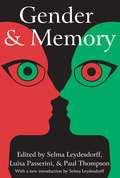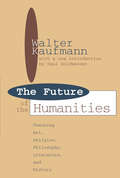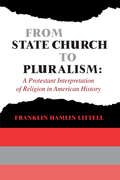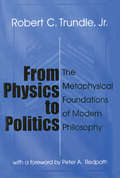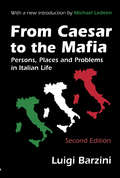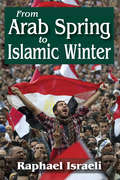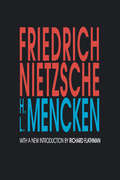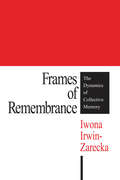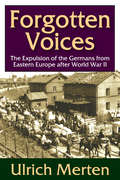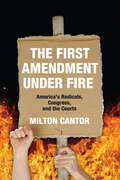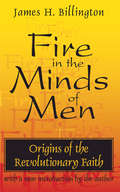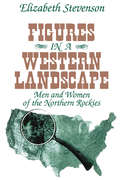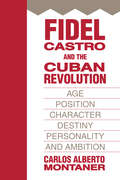- Table View
- List View
Gender and Memory
by Luisa PasseriniGender and Memory brings together contributions from around the world and from a range of disciplines--history and sociology, socio-linguistics and family therapy, literature--to create a volume that confronts all those concerned with autobiographical testimony and narrative, both spoken and written. The fundamental theme is the shaping of memory by gender. This paperback edition includes a new introduction by Selma Leydesdorff, coeditor of the Memory and Narrative series of which this volume is a part.Are the different ways in which men and women are recalled in public and private memory and the differences in men's and women's own memories of similar experiences, simply reflections of unequal lives in gendered societies, or are they more deeply rooted? The sharply differentiated life experiences of men and women in most human societies, the widespread tendencies for men to dominate in the public sphere and for women's lives to focus on family and household, suggest that these experiences may be reflected in different qualities of memory.The contributors maintain that memories are gendered, and that the gendering of memory makes a strong impact on the shaping of social spaces and expressive forms as the horizons of memory move from one generation to the next. They argue that in order to understand how memory becomes gendered, we need to travel through the realms of gendered experience and gendered language.
Future of the Humanities: Teaching Art, Religion, Philosophy, Literature and History (Foundations Of Higher Education Ser.)
by James HughesFirst Published in 2017. Routledge is an imprint of Taylor & Francis, an Informa company.
Future of the Humanities: Teaching Art, Religion, Philosophy, Literature and History
by James HughesFirst Published in 2017. Routledge is an imprint of Taylor & Francis, an Informa company.
From State Church to Pluralism: A Protestant Interpretation of Religion in American History
by Franklin LittellFor most of our history, American religious life has been dominated by a view of church history in which we appear as mere deposits of European religious culture. In fact, however, the freedom of Americans to choose without penalty to join any religious body or none at all is new in human history. This book is an effort to understand and interpret how we arrived at our present situation and, in doing so, to clarify many cultural, social and political issues.
From State Church to Pluralism: A Protestant Interpretation of Religion in American History
by Franklin LittellFor most of our history, American religious life has been dominated by a view of church history in which we appear as mere deposits of European religious culture. In fact, however, the freedom of Americans to choose without penalty to join any religious body or none at all is new in human history. This book is an effort to understand and interpret how we arrived at our present situation and, in doing so, to clarify many cultural, social and political issues.
From Physics to Politics: The Metaphysical Foundations of Modern Philosophy
by Robert TrundleMass ideology is unique to modern society and rooted in early modern philosophy. Traditionally, knowledge had been viewed as resting on metaphysics. Rejecting metaphysical truth evoked questions about the source of -truth.- For nineteenth-century ideologists, -truth- comes either from dominating classes in a progressively determined history or from a post-Copernican freedom of the superior man to create it. In From Physics to Politics Robert C. Trundle, Jr. uncovers the relation of modern philosophy to political ideology. And in rooting truth in human nature and Nature by modal reasoning, he resolves the problem of politicized truth. Our concepts of scientific truth, logic, and necessity are essentially connected. Modern philosophy restricts our understanding of necessity to the political dreams and aspirations of Enlightenment intellectuals. As a result, these intellectuals refuse to acknowledge as factual or meaningful whatever is not intelligible within the practical goals of establishing science as a system of enlightened ideas. The effect of these ideas is that in our time metaphysical principles, speculative truths, our understanding of science, and the nature of logic have become subordinated to ideological dreams. Fascism, Nazism, Marxism, political correctness, and moral relativism are not historical aberrations but essential consequences. Trundle's work is groundbreaking and daring, and his underlying thesis demonstrates why scientific truth demands a modal defense. The defense not only integrates science, ethics, and politics, but shows how -truth- may be ascribed to moral and scientific principles in contrast to a modern philosophical tradition. Since this tradition is the origin of political ideology, it has led to an irrational politicization of truth. The book will appeal particularly to those interested in political history, histories of philosophy, the philosophy of sciences, and ethics.
From Physics to Politics: The Metaphysical Foundations of Modern Philosophy
by Robert TrundleMass ideology is unique to modern society and rooted in early modern philosophy. Traditionally, knowledge had been viewed as resting on metaphysics. Rejecting metaphysical truth evoked questions about the source of -truth.- For nineteenth-century ideologists, -truth- comes either from dominating classes in a progressively determined history or from a post-Copernican freedom of the superior man to create it. In From Physics to Politics Robert C. Trundle, Jr. uncovers the relation of modern philosophy to political ideology. And in rooting truth in human nature and Nature by modal reasoning, he resolves the problem of politicized truth. Our concepts of scientific truth, logic, and necessity are essentially connected. Modern philosophy restricts our understanding of necessity to the political dreams and aspirations of Enlightenment intellectuals. As a result, these intellectuals refuse to acknowledge as factual or meaningful whatever is not intelligible within the practical goals of establishing science as a system of enlightened ideas. The effect of these ideas is that in our time metaphysical principles, speculative truths, our understanding of science, and the nature of logic have become subordinated to ideological dreams. Fascism, Nazism, Marxism, political correctness, and moral relativism are not historical aberrations but essential consequences. Trundle's work is groundbreaking and daring, and his underlying thesis demonstrates why scientific truth demands a modal defense. The defense not only integrates science, ethics, and politics, but shows how -truth- may be ascribed to moral and scientific principles in contrast to a modern philosophical tradition. Since this tradition is the origin of political ideology, it has led to an irrational politicization of truth. The book will appeal particularly to those interested in political history, histories of philosophy, the philosophy of sciences, and ethics.
From Caesar to the Mafia: Persons, Places and Problems in Italian Life
by Luigi BarziniDescribed by Melvin Lasky as "one of the great journalists of our time," Luigi Barzini was also one of the great cultural historians of modern Italy. From Caesar to the Mafia brings together his finest essays, roughly half of them never before published in the English language. Whether discussing the deep Italian roots of Julius Caesar, Casanova's contribution to the art of living big, or Camillo Cavour's contribution to a democratic as well as integrated nation, Barzini makes Italian culture come alive. Whether he is dealing with heroes or villains, he never loses sight of how Italy became a distinct nation.From Caesar to the Mafia is not only about people, but also focuses on places and problems. When Barzini discusses the Sicilians, the Isle of Capri, or his birthplace of Milan, he has the distinct capacity to capture what is universal as well as what is intimate in each place. An innate sense of psychological profiling enriches these intimate sketches. Because Barzini had such a keen appreciation of Anglo-American culture he emphasizes people and places known to travelers to Italy, as well as readers of Italian literature. What makes the volume so special is Barzini's careful maneuvering between sentimentality on one side and brutality on the other.Italy is not only a state of mind for Barzini, but also a political culture. By discussing the exaggerated mannerism of Mussolini or the unusual capacity of Gramsci to grasp the principles of revolution making in an underdeveloped country, he helps us better understand the operations of fascism and communism as system and ideology. The final essays give voice to Barzini's ability as a political analyst. His examination of the Italian Communist Party's multiple personality disorders, the Christian Democrats as working compromise, the Mafia as a system of power designed not so much to kill as to intimidate and to rule in the absence of popular resistance, tells the reader about modern,
From Caesar to the Mafia: Persons, Places and Problems in Italian Life
by Luigi BarziniDescribed by Melvin Lasky as "one of the great journalists of our time," Luigi Barzini was also one of the great cultural historians of modern Italy. From Caesar to the Mafia brings together his finest essays, roughly half of them never before published in the English language. Whether discussing the deep Italian roots of Julius Caesar, Casanova's contribution to the art of living big, or Camillo Cavour's contribution to a democratic as well as integrated nation, Barzini makes Italian culture come alive. Whether he is dealing with heroes or villains, he never loses sight of how Italy became a distinct nation.From Caesar to the Mafia is not only about people, but also focuses on places and problems. When Barzini discusses the Sicilians, the Isle of Capri, or his birthplace of Milan, he has the distinct capacity to capture what is universal as well as what is intimate in each place. An innate sense of psychological profiling enriches these intimate sketches. Because Barzini had such a keen appreciation of Anglo-American culture he emphasizes people and places known to travelers to Italy, as well as readers of Italian literature. What makes the volume so special is Barzini's careful maneuvering between sentimentality on one side and brutality on the other.Italy is not only a state of mind for Barzini, but also a political culture. By discussing the exaggerated mannerism of Mussolini or the unusual capacity of Gramsci to grasp the principles of revolution making in an underdeveloped country, he helps us better understand the operations of fascism and communism as system and ideology. The final essays give voice to Barzini's ability as a political analyst. His examination of the Italian Communist Party's multiple personality disorders, the Christian Democrats as working compromise, the Mafia as a system of power designed not so much to kill as to intimidate and to rule in the absence of popular resistance, tells the reader about modern,
From Arab Spring to Islamic Winter
by Raphael IsraeliThe world is watching with uncertainity as the "Arab Spring" unfolds. Optimistically named by international media sources, the term "Arab Spring" associates the unrest with ideas of renewal, revival, and democratic thought and deed. Many hoped the overthrow of authoritarian leaders signaled a promising new beginning for the Arab world. Raphael Israeli argues that instead of paving a path toward liberal democracy, the Arab Spring in fact launched a power struggle. Judging from the experiences of countries where the dust is settling-including Tunisia, Egypt, Yemen, and perhaps also Syria and Libya-it appears that Islamic governments will fill the vacuum in leadership. The hopes that swept the Islamic world with the Arab Spring have given way to a winter of lost hopes and aspirations, as it becomes increasingly clear that democratic outcomes are not on the horizon. What is worse is that the West seems to have abandoned its hopes for democracy and freedom in the region, instead making peace with the idea that Islamic governments must be accepted as the lesser of evil options. Presenting a clear-eyed picture of the situation, Israeli examines thematic problems that cut across all the Muslim states experiencing unrest. He groups the countries into various blocs according to their shared characteristics, then discusses these groups one by one. For each country, he considers whether the liberal-democratic option is viable and examines what kind of regime could be considered legitimate and stable. This volume offers valuable insights for political scientists, Middle Eastern specialists, and the general informed public eager to comprehend the import of these momentous events.
From Arab Spring to Islamic Winter
by Raphael IsraeliThe world is watching with uncertainity as the "Arab Spring" unfolds. Optimistically named by international media sources, the term "Arab Spring" associates the unrest with ideas of renewal, revival, and democratic thought and deed. Many hoped the overthrow of authoritarian leaders signaled a promising new beginning for the Arab world. Raphael Israeli argues that instead of paving a path toward liberal democracy, the Arab Spring in fact launched a power struggle. Judging from the experiences of countries where the dust is settling-including Tunisia, Egypt, Yemen, and perhaps also Syria and Libya-it appears that Islamic governments will fill the vacuum in leadership. The hopes that swept the Islamic world with the Arab Spring have given way to a winter of lost hopes and aspirations, as it becomes increasingly clear that democratic outcomes are not on the horizon. What is worse is that the West seems to have abandoned its hopes for democracy and freedom in the region, instead making peace with the idea that Islamic governments must be accepted as the lesser of evil options. Presenting a clear-eyed picture of the situation, Israeli examines thematic problems that cut across all the Muslim states experiencing unrest. He groups the countries into various blocs according to their shared characteristics, then discusses these groups one by one. For each country, he considers whether the liberal-democratic option is viable and examines what kind of regime could be considered legitimate and stable. This volume offers valuable insights for political scientists, Middle Eastern specialists, and the general informed public eager to comprehend the import of these momentous events.
Friedrich Nietzsche
by H.L. MenckenThe decisive influence of Friedrich Nietzsche on H.L. Mencken is readily acknowledged in the vast literature on the great American journalist and social critic. However, Mencken's 1908 study of the philosopher has been relegated to footnote status by Mencken's critics and biographers and has been largely ignored by Nietzsche scholars. There are good reasons for reversing this judgment. Mencken's work was one of the first comprehensive and sympathetic treatments of Nietzsche's thought in the English language. It is a provocative engagement with the German philosopher's complex and elusive ideas, enhanced by a style that reverberates with a verve and dynamism approaching Nietzsche's own.Mencken presents a view of Nietzsche that elucidates the latter's complex and contentious form of the "gospel of individualism" while evincing a keen appreciation of his unrivalled capacity for critical analysis. The historical scope of Nietzsche's thought is fully evident in Mencken's analysis as is its application to modern societies and politics. In tracing the biographical and intellectual impetus for Nietzsche's relentless attacks on conventional moralities and established modes of thought, Mencken discerned both an ideal and a method for grappling with social and cultural issues that remain salient in our own time.
Friedrich Nietzsche
by H.L. MenckenThe decisive influence of Friedrich Nietzsche on H.L. Mencken is readily acknowledged in the vast literature on the great American journalist and social critic. However, Mencken's 1908 study of the philosopher has been relegated to footnote status by Mencken's critics and biographers and has been largely ignored by Nietzsche scholars. There are good reasons for reversing this judgment. Mencken's work was one of the first comprehensive and sympathetic treatments of Nietzsche's thought in the English language. It is a provocative engagement with the German philosopher's complex and elusive ideas, enhanced by a style that reverberates with a verve and dynamism approaching Nietzsche's own.Mencken presents a view of Nietzsche that elucidates the latter's complex and contentious form of the "gospel of individualism" while evincing a keen appreciation of his unrivalled capacity for critical analysis. The historical scope of Nietzsche's thought is fully evident in Mencken's analysis as is its application to modern societies and politics. In tracing the biographical and intellectual impetus for Nietzsche's relentless attacks on conventional moralities and established modes of thought, Mencken discerned both an ideal and a method for grappling with social and cultural issues that remain salient in our own time.
Frames of Remembrance: The Dynamics of Collective Memory
by Iwona Irwin-ZareckaWhat is the symbolic impact of the Vietnam War Memorial? How does television change our engagement with the past? Can the efforts to wipe out Communist legacies succeed? Should victims of the Holocaust be celebrated as heroes or as martyrs? These questions have a great deal in common, yet they are typically asked separately by people working in distinct research areas in different disciplines. Frames of Remembrance shares ideas and concerns across such divides.
Frames of Remembrance: The Dynamics of Collective Memory
by Iwona Irwin-ZareckaWhat is the symbolic impact of the Vietnam War Memorial? How does television change our engagement with the past? Can the efforts to wipe out Communist legacies succeed? Should victims of the Holocaust be celebrated as heroes or as martyrs? These questions have a great deal in common, yet they are typically asked separately by people working in distinct research areas in different disciplines. Frames of Remembrance shares ideas and concerns across such divides.
Forgotten Voices: The Expulsion of the Germans from Eastern Europe After World War II
by Ulrich MertenThe news agency Reuters reported in 2009 that a mass grave containing 1,800 bodies was found in Malbork, Poland. Polish authorities suspected that they were German civilians that were killed by advancing Soviet forces. A Polish archeologist supervising the exhumation, said, "We are dealing with a mass grave of civilians, probably of German origin. The presence of children . . . suggests they were civilians."During World War II, the German Nazi regime committed great crimes against innocent civilian victims: Jews, Poles, Russians, Serbs, and other people of Central and Eastern Europe. At war's end, however, innocent German civilians in turn became victims of crimes against humanity. Forgotten Voices lets these victims of ethnic cleansing tell their story in their own words, so that they and what they endured are not forgotten. This volume is an important supplement to the voices of victims of totalitarianism and has been written in order to keep the historical record clear.The root cause of this tragedy was ultimately the Nazi German regime. As a leading German historian, Hans-Ulrich Wehler has noted, "Germany should avoid creating a cult of victimization, and thus forgetting Auschwitz and the mass killing of Russians." Ulrich Merten argues that applying collective punishment to an entire people is a crime against humanity. He concludes that this should also be recognized as a European catastrophe, not only a German one, because of its magnitude and the broad violation of human rights that occurred on European soil.Supplementary maps and pictures are available online at http://www.forgottenvoices.net
Forgotten Voices: The Expulsion of the Germans from Eastern Europe After World War II
by Ulrich MertenThe news agency Reuters reported in 2009 that a mass grave containing 1,800 bodies was found in Malbork, Poland. Polish authorities suspected that they were German civilians that were killed by advancing Soviet forces. A Polish archeologist supervising the exhumation, said, "We are dealing with a mass grave of civilians, probably of German origin. The presence of children . . . suggests they were civilians."During World War II, the German Nazi regime committed great crimes against innocent civilian victims: Jews, Poles, Russians, Serbs, and other people of Central and Eastern Europe. At war's end, however, innocent German civilians in turn became victims of crimes against humanity. Forgotten Voices lets these victims of ethnic cleansing tell their story in their own words, so that they and what they endured are not forgotten. This volume is an important supplement to the voices of victims of totalitarianism and has been written in order to keep the historical record clear.The root cause of this tragedy was ultimately the Nazi German regime. As a leading German historian, Hans-Ulrich Wehler has noted, "Germany should avoid creating a cult of victimization, and thus forgetting Auschwitz and the mass killing of Russians." Ulrich Merten argues that applying collective punishment to an entire people is a crime against humanity. He concludes that this should also be recognized as a European catastrophe, not only a German one, because of its magnitude and the broad violation of human rights that occurred on European soil.Supplementary maps and pictures are available online at http://www.forgottenvoices.net
First Amendment Under Fire: America's Radicals, Congress, and the Courts
by Milton CantorThe First Amendment is perhaps the most important - and most debated - amendment in the US Constitution. It establishes freedom of speech, as well as that of religion, the press, peaceable assembly and the right to petition the government. But how has the interpretation of this amendment evolved? Milton Cantor explores America's political response to the challenges of social unrest and how it shaped the meaning of the First Amendment throughout the twentieth century. This multi-layered study of dissent in the United States from the early 1900s through the 1970s describes how Congress and the law dealt with anarchists, syndicalists, socialists, and militant labor groups, as well as communists and left-of-center liberals. Cantor describes these organizations' practices, policies, and policy shifts against the troubled background of war and overseas affairs. The volume chronologically explores each new challenge - both events and legislation - for the First Amendment and how the public and branches of government reacted. The meaning of the First Amendment was defined in the crucible of threats to national security. Some perceived threats were wartime events; the First World War instigated awareness of civil liberties, but in those times, security trumped liberty. In the peace that followed, efforts to curtail speech continued to prevail. Cantor analyzes the decades-long divisiveness regarding First Amendment decisions in the Supreme Court, coming down squarely in criticism of those who have argued for greater government control over speech.
First Amendment Under Fire: America's Radicals, Congress, and the Courts
by Milton CantorThe First Amendment is perhaps the most important - and most debated - amendment in the US Constitution. It establishes freedom of speech, as well as that of religion, the press, peaceable assembly and the right to petition the government. But how has the interpretation of this amendment evolved? Milton Cantor explores America's political response to the challenges of social unrest and how it shaped the meaning of the First Amendment throughout the twentieth century. This multi-layered study of dissent in the United States from the early 1900s through the 1970s describes how Congress and the law dealt with anarchists, syndicalists, socialists, and militant labor groups, as well as communists and left-of-center liberals. Cantor describes these organizations' practices, policies, and policy shifts against the troubled background of war and overseas affairs. The volume chronologically explores each new challenge - both events and legislation - for the First Amendment and how the public and branches of government reacted. The meaning of the First Amendment was defined in the crucible of threats to national security. Some perceived threats were wartime events; the First World War instigated awareness of civil liberties, but in those times, security trumped liberty. In the peace that followed, efforts to curtail speech continued to prevail. Cantor analyzes the decades-long divisiveness regarding First Amendment decisions in the Supreme Court, coming down squarely in criticism of those who have argued for greater government control over speech.
Fire in the Minds of Men: Origins of the Revolutionary Faith
by James H BillingtonThis book traces the origins of a faith--perhaps the faith of the century. Modern revolutionaries are believers, no less committed and intense than were Christians or Muslims of an earlier era. What is new is the belief that a perfect secular order will emerge from forcible overthrow of traditional authority. This inherently implausible idea energized Europe in the nineteenth century, and became the most pronounced ideological export of the West to the rest of the world in the twentieth century. Billington is interested in revolutionaries--the innovative creators of a new tradition. His historical frame extends from the waning of the French Revolution in the late eighteenth century to the beginnings of the Russian Revolution in the early twentieth century. The theater was Europe of the industrial era; the main stage was the journalistic offices within great cities such as Paris, Berlin, London, and St. Petersburg. Billington claims with considerable evidence that revolutionary ideologies were shaped as much by the occultism and proto-romanticism of Germany as the critical rationalism of the French Enlightenment. The conversion of social theory to political practice was essentially the work of three Russian revolutions: in 1905, March 1917, and November 1917. Events in the outer rim of the European world brought discussions about revolution out of the school rooms and press rooms of Paris and Berlin into the halls of power.Despite his hard realism about the adverse practical consequences of revolutionary dogma, Billington appreciates the identity of its best sponsors, people who preached social justice transcending traditional national, ethnic, and gender boundaries. When this book originally appeared The New Republic hailed it as "remarkable, learned and lively," while The New Yorker noted that Billington "pays great attention to the lives and emotions of individuals and this makes his book absorbing." It is an invaluable work of history and contribution to our understanding of political life.
Fire in the Minds of Men: Origins of the Revolutionary Faith
by James H BillingtonThis book traces the origins of a faith--perhaps the faith of the century. Modern revolutionaries are believers, no less committed and intense than were Christians or Muslims of an earlier era. What is new is the belief that a perfect secular order will emerge from forcible overthrow of traditional authority. This inherently implausible idea energized Europe in the nineteenth century, and became the most pronounced ideological export of the West to the rest of the world in the twentieth century. Billington is interested in revolutionaries--the innovative creators of a new tradition. His historical frame extends from the waning of the French Revolution in the late eighteenth century to the beginnings of the Russian Revolution in the early twentieth century. The theater was Europe of the industrial era; the main stage was the journalistic offices within great cities such as Paris, Berlin, London, and St. Petersburg. Billington claims with considerable evidence that revolutionary ideologies were shaped as much by the occultism and proto-romanticism of Germany as the critical rationalism of the French Enlightenment. The conversion of social theory to political practice was essentially the work of three Russian revolutions: in 1905, March 1917, and November 1917. Events in the outer rim of the European world brought discussions about revolution out of the school rooms and press rooms of Paris and Berlin into the halls of power.Despite his hard realism about the adverse practical consequences of revolutionary dogma, Billington appreciates the identity of its best sponsors, people who preached social justice transcending traditional national, ethnic, and gender boundaries. When this book originally appeared The New Republic hailed it as "remarkable, learned and lively," while The New Yorker noted that Billington "pays great attention to the lives and emotions of individuals and this makes his book absorbing." It is an invaluable work of history and contribution to our understanding of political life.
Figures in a Western Landscape: Men and Women of the Northern Rockies
by Elizabeth Stevenson""Figures in a Western Landscape is an absolutely stunning book. A biographer's take on the story of the American West, it posits that the turns of history are based on people-major 'figures' who shape their time and place. In her sequence of biographical essays, Elizabeth Stevenson tells the story of the northern Rockies and, in particular, Montana, a state of mind even more than it is a state of the Union. As her readers have come to expect, she offers more than a mere recounting of events. Stevenson captures the humanity of her subjects."" -Charles Little, author of Louis Bromfield at Malabar and Greenways for AmericaThe northern Rocky Mountains and adjacent high plains were the last American West. Here was the final enactment of our national drama-the last explorations, the final battles of the Indian wars, the closing of the frontier. In Figures in a Western Landscape, award-winning biographer Elizabeth Stevenson humanizes the history of the region with a procession of individual lives moving across generations. Each of the sixteen men and women depicted left behind his or her own unique written record or oral history. The stories they have bequeathed are rich in revealing anecdote and colorful detail. Among them: Meriwether Lewis, America's ""most introspective explorer,"" John Kirk Townsend, known to the Chinooks as ""the bird chief,"" Pretty-Shield, wife of the Crow scout who warned Custer to turn back at Little Big Horn, James and Granville Stuart, early settlers lured by rumors of gold in the 1850s.In a concluding chapter, Stevenson draws on previously unpublished material to reveal new information about Martha Jane Cannary Burke, better known as Calamity Jane, the woman who could ride, shoot, and drive a mule team as well as any man (but who once failed to ""pass"" because she didn't cuss her mules like one). She lies buried in Deadwood, South Dakota, next to the man some said was her husband, Wild Bill Hickok.These and other men and women whose stories Stevenson
Figures in a Western Landscape: Men and Women of the Northern Rockies
by Elizabeth Stevenson""Figures in a Western Landscape is an absolutely stunning book. A biographer's take on the story of the American West, it posits that the turns of history are based on people-major 'figures' who shape their time and place. In her sequence of biographical essays, Elizabeth Stevenson tells the story of the northern Rockies and, in particular, Montana, a state of mind even more than it is a state of the Union. As her readers have come to expect, she offers more than a mere recounting of events. Stevenson captures the humanity of her subjects."" -Charles Little, author of Louis Bromfield at Malabar and Greenways for AmericaThe northern Rocky Mountains and adjacent high plains were the last American West. Here was the final enactment of our national drama-the last explorations, the final battles of the Indian wars, the closing of the frontier. In Figures in a Western Landscape, award-winning biographer Elizabeth Stevenson humanizes the history of the region with a procession of individual lives moving across generations. Each of the sixteen men and women depicted left behind his or her own unique written record or oral history. The stories they have bequeathed are rich in revealing anecdote and colorful detail. Among them: Meriwether Lewis, America's ""most introspective explorer,"" John Kirk Townsend, known to the Chinooks as ""the bird chief,"" Pretty-Shield, wife of the Crow scout who warned Custer to turn back at Little Big Horn, James and Granville Stuart, early settlers lured by rumors of gold in the 1850s.In a concluding chapter, Stevenson draws on previously unpublished material to reveal new information about Martha Jane Cannary Burke, better known as Calamity Jane, the woman who could ride, shoot, and drive a mule team as well as any man (but who once failed to ""pass"" because she didn't cuss her mules like one). She lies buried in Deadwood, South Dakota, next to the man some said was her husband, Wild Bill Hickok.These and other men and women whose stories Stevenson
Fidel Castro and the Cuban Revolution: Age, Position, Character, Destiny, Personality, and Ambition
by Carlos Alberto MontanerPerhaps the foremost social analyst and journalist on Cuban affairs, Carlos Alberto Montaner has written a definitive study of the Cuban regime from the vantage point of the Cuban dictator. This is not simply a history of Cuban communism but rather a personal history of its leader, Fidel Castro. Montaner's extraordinary knowledge of the country and its politics prevents the work from becoming a psychiatric examination from afar. Indeed, what personal irrationalities exist are seen as built into the fabric of the regime itself, and not simply as a personality aberration.Fidel Castro and the Cuban Revolution is not an apologia for past United States involvement in Cuban affairs. The author is severe in his judgments of such participation. Nor is he sparing in his sense of the betrayal of the original purposes of the Revolution of 1959 manifested in the character and policies of Fidel Castro. As the work progresses from a study of the victims to a study of the beneficiaries of the Cuban Revolution, it leaves the reader with a deep sense of the tragedy of a revolution betrayed, but not one that could have easily been avoided.Montaner is an ""exile"" like the great Alexander Herzen before him. His decision to live in Europe was made by choice, not of necessity. He sees his role as critical analyst, not as restoring the status quo ante. A most valuable aspect of this book is its intimate reevaluation of Fulgencio Batista. Whatever the reader's judgment of Montaner's work, no one can read it and be dismissive of the effort. It is a work of intimacy even through written in exile--and hence must be viewed as an important effort to understand the character of the man and regime who have changed the course of Cuban history in our times.
Fidel Castro and the Cuban Revolution: Age, Position, Character, Destiny, Personality, and Ambition
by Carlos Alberto MontanerPerhaps the foremost social analyst and journalist on Cuban affairs, Carlos Alberto Montaner has written a definitive study of the Cuban regime from the vantage point of the Cuban dictator. This is not simply a history of Cuban communism but rather a personal history of its leader, Fidel Castro. Montaner's extraordinary knowledge of the country and its politics prevents the work from becoming a psychiatric examination from afar. Indeed, what personal irrationalities exist are seen as built into the fabric of the regime itself, and not simply as a personality aberration.Fidel Castro and the Cuban Revolution is not an apologia for past United States involvement in Cuban affairs. The author is severe in his judgments of such participation. Nor is he sparing in his sense of the betrayal of the original purposes of the Revolution of 1959 manifested in the character and policies of Fidel Castro. As the work progresses from a study of the victims to a study of the beneficiaries of the Cuban Revolution, it leaves the reader with a deep sense of the tragedy of a revolution betrayed, but not one that could have easily been avoided.Montaner is an ""exile"" like the great Alexander Herzen before him. His decision to live in Europe was made by choice, not of necessity. He sees his role as critical analyst, not as restoring the status quo ante. A most valuable aspect of this book is its intimate reevaluation of Fulgencio Batista. Whatever the reader's judgment of Montaner's work, no one can read it and be dismissive of the effort. It is a work of intimacy even through written in exile--and hence must be viewed as an important effort to understand the character of the man and regime who have changed the course of Cuban history in our times.
